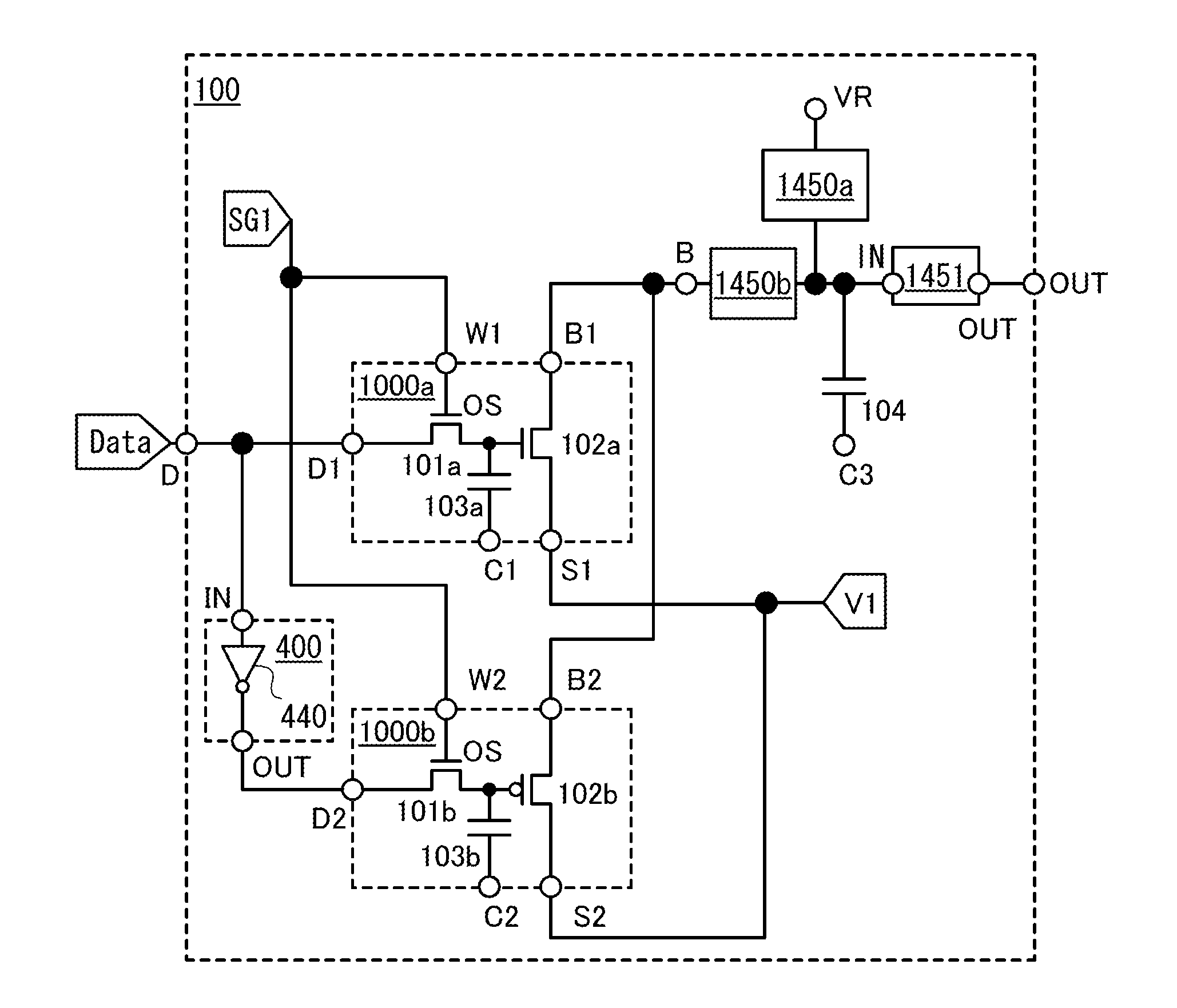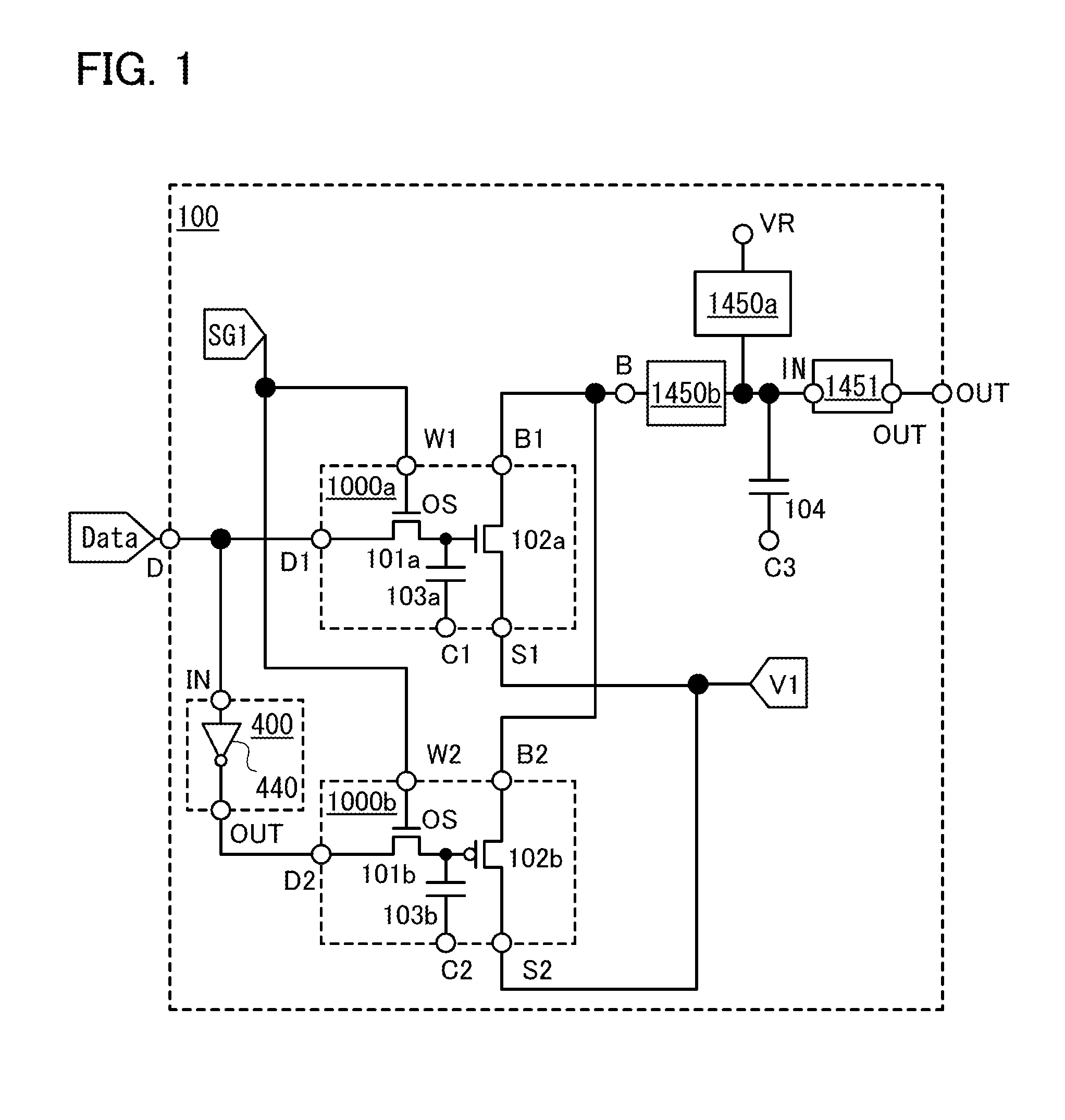Memory element and signal processing circuit
a signal processing circuit and memory element technology, applied in the field of memory element and signal processing circuit, can solve the problems of limited rewriting time, writing error, limited rewriting time, etc., and achieve the effects of reducing the frequency of rewritable times, reducing the degradation of the element, and increasing the number of rewritable times of data
- Summary
- Abstract
- Description
- Claims
- Application Information
AI Technical Summary
Benefits of technology
Problems solved by technology
Method used
Image
Examples
embodiment 1
Structure 1 of Memory Element
[0088]FIG. 1 illustrates a memory element that is one embodiment of the present invention. In FIG. 1, a memory element 100 includes a circuit 1000a, a circuit 1000b, an inverter circuit 400, a sense amplifier 1451, a switch 1450a, a switch 1450b, and a capacitor 104. Data is input to a terminal D, and the memory element 100 holds a signal corresponding to the data and outputs the signal corresponding to the data from a terminal OUT. The circuit 1000a includes a transistor 101a, a transistor 102a, and a capacitor 103a. The circuit 1000b includes a transistor 101b, a transistor 102b, and a capacitor 103b. Note that one or all of the capacitor 103a, the capacitor 103b, and the capacitor 104 can be omitted by positively using a parasitic capacitance or the like.
[0089]In the circuit 1000a, a gate of the transistor 101a is electrically connected to a terminal W1, one of a source and a drain of the transistor 101a is electrically connected to a terminal D1, and...
embodiment 2
Structure 2 of Memory Element
[0115]FIG. 8 illustrates a memory element that is another embodiment of the present invention. In FIG. 8, a memory element 100 includes a circuit 1000a, a circuit 1000b, a sense amplifier 1451, a switch 8450a, a switch 8450b, a capacitor 104a, a switch 9450a, a switch 9450b, and a capacitor 104b. Data is input to a terminal D, and the memory element 100 holds a signal corresponding to the data and outputs the signal corresponding to the data from a terminal OUT. The circuit 1000a includes a transistor 101a, a transistor 102a, and a capacitor 103a. The circuit 1000b includes a transistor 101b, a transistor 102b, and a capacitor 103b. Note that one or all of the capacitor 103a, the capacitor 103b, the capacitor 104a, and the capacitor 104b can be omitted by positively using a parasitic capacitance or the like.
[0116]In the circuit 1000a, a gate of the transistor 101a is electrically connected to a terminal W1, one of a source and a drain of the transistor 1...
embodiment 3
Structure 3 of Memory Element
[0141]FIG. 13 illustrates a memory element that is another embodiment of the present invention. In FIG. 13, a memory element 100 includes a circuit 1000a, a circuit 1000b, an inverter circuit 400, a sense amplifier 1451, a switch 8450a, a switch 8450b, a capacitor 104a, a switch 9450a, and a capacitor 104b. Data is input to a terminal D, and the memory element 100 holds a signal corresponding to the data and outputs the signal corresponding to the data from a terminal OUT. The circuit 1000a includes a transistor 101a, a transistor 102a, and a capacitor 103a. The circuit 1000b includes a transistor 101b, a transistor 102b, and a capacitor 103b. Note that one or all of the capacitor 103a, the capacitor 103b, the capacitor 104a, and the capacitor 104b can be omitted by positively using a parasitic capacitance or the like.
[0142]In the circuit 1000a, a gate of the transistor 101a is electrically connected to a terminal W1, one of a source and a drain of the t...
PUM
 Login to View More
Login to View More Abstract
Description
Claims
Application Information
 Login to View More
Login to View More - R&D
- Intellectual Property
- Life Sciences
- Materials
- Tech Scout
- Unparalleled Data Quality
- Higher Quality Content
- 60% Fewer Hallucinations
Browse by: Latest US Patents, China's latest patents, Technical Efficacy Thesaurus, Application Domain, Technology Topic, Popular Technical Reports.
© 2025 PatSnap. All rights reserved.Legal|Privacy policy|Modern Slavery Act Transparency Statement|Sitemap|About US| Contact US: help@patsnap.com



